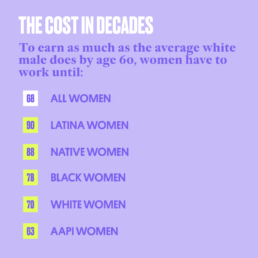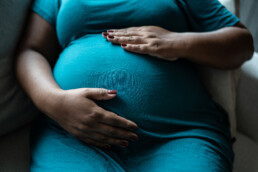Facing 10 Years of Prison for Smoking Weed
 March 19, 2024 Greetings, Meteor readers, It’s last call for any of you wanting to participate in our March Madness challenge! Just click the button below to join our group and share your women’s bracket. And don’t forget, the best way to support women’s sports is to watch: Most games will be available on ESPN2 or ESPNU, but UConn v. Jackson State and Iowa v. Holy Cross—featuring Paige Bueckers and Caitlin Clark, of course—will be on ABC. In today’s newsletter, I promise not to speak further of basketball. Instead, Samhita Mukhopadhyay walks us through Oprah’s weight loss special. Plus, a new book for your TBR pile and a princess sighting. Ball is life, Shannon Melero  WHAT'S GOING ONOprah is done with the fat shaming…again: ICYMI, Oprah has another special out about weight shame and drugs like Ozempic. Released yesterday on the heels of her decision to step down from the Weight Watchers board and share with the public that she herself is on a semaglutide (the much talked about class of drugs like Ozempic and Mounjaro), the show was an effort at busting common myths around obesity. As someone who’s written about the topic, I thought I’d break down the good and less-good coverage: The good: She emphasized one of the most groundbreaking shifts in thinking that has come thanks to the popularity of these new “obesity meds”—the understanding that weight gain is not solely connected to your willpower. People often discriminate against and hate fat bodies because they believe fat people lack the personal control not to be fat, and, for this reason, deserve the shame and admonishment we as a society dole out to them. In developing drugs that address physiological components, science is confirming what fat activists have long said: Some of our bodies are just different, and the only path forward is to accept that. But here’s where the special missed the mark: Rather than rethink what our hatred of fat bodies means for society and medical institutions—something that would be groundbreaking for Oprah to do—she purports that one of the only ways to eradicate this stigma is to become unfat, most notably through the help of this new class of drugs. (The special features several weight loss “success” stories of people whose lives changed dramatically by taking a semaglutide). But why is being fat something that needs to be solved? It’s great that Oprah is undoing the shame we feel around our decision to take these drugs—but perhaps it’s also okay to just be fat. (FWIW, I believe Oprah knows this truth; it’s just not an easy one to get across in primetime.) The only people who should really feel shame are those who continue to perpetuate the idea that the only way to live a healthy, happy life is to be thin. For more on how Oprah has contributed to how we talk and think about weight loss, check out this episode of In Retrospect about her lifelong, public battle with her weight and what it’s meant for the culture. At the top of her special, Oprah admits she gave in to the pressure to apologize for her weight and refuses to do so anymore. I’m happy for her. But what would it look like to embrace such an attitude without also recentering thinness? AND:
 ONE WOMAN'S FIGHT“This Isn't Speedy or Fair”Lauren Smith’s waited over four years for her day in court.BY NEDA TOLOUI-SEMNANI  LAUREN SMITH HAS BEEN SEPARATED FROM HER YOUNGEST CHILD FOR FIVE YEARS. (IMAGE VIA THE METEOR) Four months ago, I wrote in this space about Lauren Smith, a 32-year-old mother who lost custody of her youngest child in 2019 after she and her infant tested positive for THC, a cannabinoid substance, at delivery. Smith was arrested six months later and charged with felony child neglect for using marijuana while pregnant—a charge which, in Greenville, South Carolina, carries a sentence of up to 10 years in prison. When we published the article, Smith’s trial date was set for the week of February 19, 2024, which was, rather poetically, five years nearly to the day after she had delivered and lost custody of her youngest daughter. The child has been living with her paternal grandmother since she was three days old. But weeks before the trial was set to start, Smith learned her court date would be pushed for a third time. It is now scheduled for the week of April 22. “Isn't everybody due a speedy, fair trial?” Smith told me earlier this month. “This isn't speedy or fair.” The latest holdup comes after the Greenville County solicitor's office entered more than 125 pages of new documentation into discovery. This is called a “document dump,” a legal maneuver in which one side enters hundreds, sometimes thousands, of pages of new documentation within weeks of trial in an effort to overwhelm the opposing side. (This is the second time the prosecution has used this delay tactic. The first was last May when they entered several hundred additional pages of documentation as discovery.) Despite the U.S. Constitution guaranteeing the right to a fast trial, Stuart Sarratt, a former Greenville County public defender familiar with the Smith case, says, “South Carolina essentially does not have any kind of right to speedy trial.”  PHOTO BY NILO TABRIZI Neda Toloui-Semnani is an Emmy-winning journalist and the author of They Said They Wanted Revolution: A Memoir of My Parents.  FOLLOW THE METEOR Thank you for reading The Meteor! Got this from a friend? Sign up for your own copy, sent Tuesdays and Thursdays.
|
![]()
Young People Are Two Times More Likely to Identify as LGBTQ+
 March 14, 2024 Evening Meteor readers, My child has been making little paintings of animals for the last few days, and I’ve decided to retire as a writer and live off of what is sure to be her prolific career as an artist. So I guess this is goodbye. I’ll remember to invite all of you to her opening night at The Met.  "THE LAST PENGUIN" BY THE ARTIST KNOWN ONLY AS V In today’s newsletter, we congratulate all the people who told Gallup they were queer. Plus, how Olivia Rodrigo is setting the standard for politically minded artists, and our weekend reading list. Shannon Melero  WHAT'S GOING ONWe’re here, we’re queer: Yesterday, Gallup released the findings of a major 12,000-person 2023 survey on sexual orientation and gender identity, revealing a sharp increase in young adults identifying as queer over the last few years. “LGBTQ+ identification in the U.S. continues to grow, with 7.6% of U.S. adults now identifying as…some other sexual orientation besides heterosexual.” This is a notable uptick from just four years ago, when just 5.6% of adults identified as LGBTQ+. So: Who’s most likely to say they’re LGBTQ+? First of all, young people. According to the data, Gen Z and millennials are twice as likely to identify as LGBTQ+ than older generations.  And the rise is also being driven by women. Among Gen Z respondents—the group who most self-identified as LGBTQ+—women were almost three times as likely as men to do so (28.5% of them did, vs 10.6% of men). The report also includes an important note: “The gender differences reported…do not account for the nonbinary population.” We’ll have to wait for further surveys to understand how the roughly 1% of Americans who consider themselves nonbinary identify. This is exactly the kind of data that rankles conservative lawmakers, and they’re likely to use it as a prime example of the degradation of core American values (life, liberty, and the pursuit of heteronormativity). But given the documented consequences of being unable to live life on your own terms—from depression and loneliness to suicide—the fact that so many young (and youngish) people are identifying as LGBTQ+ suggests tremendous progress in how comfortable they feel. Previous research suggests Gen Z is better equipped with “a language of gender” and peer support than previous generations were. So while extremists might see these numbers as proof of the “gay agenda,” they can also be seen as proof of societal progress—which couldn’t come at a more urgent time, considering the dark cloud of violence towards LGBTQ+ teenagers stoked by fearmongering adults like Moms for Liberty, Libs of Tiktok, and more. And the death of Nex Benedict, a transgender teenager in Oklahoma who died in February after a physical altercation at his school, shows just how fatal that violence can be. (An early autopsy report has ruled Benedict’s death a suicide, an outcome that is all too common among transgender youth—no doubt connected to the rise of anti-LGBTQ legislation, schools that don’t punish bullies, and more) Against that backdrop, a question for all of us: Now that we know so many young people are queer, what are we doing to protect them? If you or someone you know is struggling with suicidal thoughts you can reach a counselor via The Trevor Project by clicking here or texting 678-678. AND:
 FRIENDLY REMINDER!As I mentioned on Tuesday some of us at The Meteor will be cobbling together our limited knowledge of the inner workings of women’s college basketball and making official NCAA brackets. But wouldn’t it be more fun to do it with our readers? Selection Sunday is THIS weekend so put your women's bracket together and send a PDF of it to [email protected]. As the tournament progresses, I’ll track everyone’s picks until there’s only one bracketologist left standing. That lucky duck (get it? DUCK! Yes, I am placing Oregon high on my bracket don't judge me.) will get a fabulous Meteor tote and bragging rights. The cut-off for sending in your brackets is the evening of March 20, we're closing up the party after that. May the three-pointers be ever in your favor.  ME TO MY COWORKERS IF I WIN THIS THING  WEEKEND READING 📚On not calling the cops: In 2020, a young girl in New Orleans reported that she had been raped by a friend and then pressured to complete a rape kit. But shortly after that horrific day she was sexually assaulted again and this time her assailant was the police officer who escorted her to the hospital for that first rape kit. (The Washington Post) On the lookout: The internet wildfire surrounding Catherine, Princess of Wales, has shed light on a larger issue of how the general public can feel such strong ownership over one woman’s body. (The Atlantic) On knowing thyself: “The moral case for letting trans kids change their bodies.” (Intelligencer)  FOLLOW THE METEOR Thank you for reading The Meteor! Got this from a friend? Subscribe using their share code or sign up for your own copy, sent Tuesdays and Thursdays.
|
![]()
Your Body, Your Gender Pay Gap
 March 12, 2024 Greetings, Meteor readers, This weekend, while all the cool kids were watching the Oscars, I was baking bread. Not to brag (she says before bragging), but it is the best loaf I’ve made since I started learning how to bake bread a week ago. Maybe those “tradwives” were on to something? Just kidding! Katie Britt is still our collective sleep paralysis demon.  In today’s newsletter, we connect a few dots between the gender pay gap and abortion access. Plus, an update on Florida’s “Don’t Say Gay” law and, of course, that “missing” princess. Live from my kitchen, Shannon Melero P.S. This Sunday is Selection Sunday for the Women’s March Madness tournament, and if you’re making a bracket this year, there’s a fun challenge for you at the end of this newsletter.  WHAT'S GOING ONThere are no coincidences: Today is Equal Pay Day, the date that marks how far into the next year a woman will have to work to make as much money as a man in a similar position made the previous year. On average, for every dollar a non-Hispanic white man makes, a woman will earn 84 cents. Other factors that lower this number include race, parental status, full-time versus part-time employment, and geography. And when you go state by state, a pattern emerges. Take, for example, the five states with the largest pay gaps: Utah (73 cents), Louisiana, Alabama, New Hampshire (all at 75 cents), and Idaho (76 cents). What else do all of these states have in common? If you guessed abortion restrictions, then you are correct. Louisiana, Alabama, and Idaho have total bans, while Utah imposes extreme restrictions, and New Hampshire criminalizes abortion after the 24th week of pregnancy. Coincidence? I think not. But there are a few ways that the rollback of bodily autonomy plays into the larger economic status of women across the country. It’s partly simple cause and effect. The ability to have children when and how you want feeds financial independence: In the 1970s, when birth control became more accessible, women were able to slowly ascend the ranks of the workforce and get into higher-paying jobs; our paid labor now accounts for a quarter of America’s GDP. Of course, many other factors contribute to the wage gap, too—including the amount of time women spend on unpaid labor, institutional racism, the lack of social safety nets for parents, and the conservative backlash to women entering the workforce. But those factors are often worsened by the same conservative state legislatures passing abortion bans: In other words, the people passing the bans are often the same people refusing to lift the minimum wage for working families who do have babies. Still with us? And when governments are unable to see reproductive rights as a factor in economic stability, they’re willfully ignoring the financial hurdles that millions of women face and facilitating a return to the 1950s ideal of housewives and heteronormative families. Anne Boleyn once said of her stepdaughter, “She is my death and I am hers.” And that’s how it is with reproductive justice and economic progress—the death of one is the death of the other. As policy analyst and researcher Asha Banerjee wrote in a report for the Economic Policy Institute, “The states banning abortion rights have, over decades, intentionally constructed an economic policy architecture defined by weak labor standards, underfunded and purposefully dysfunctional public services, and high levels of incarceration…we find that, generally, the states enacting abortion bans are the same ones that are economically disempowering workers through other channels.” AND:
 CLICK THE LINK ABOVE TO GET YOUR UNIQUE SHARE CODE TO SEND TO A FEW FRIENDS. IF FIVE OF THEM SIGN UP FOR THIS NEWSLETTER, YOU GET A METEOR TOTE! ALREADY HAVE A CODE BUT CAN'T FIND IT? NO WORRIES, IT'S WAITING FOR YOU DOWN BELOW ⬇️
 FRIENDLY COMPETITION 🏀So about that fun challenge I mentioned up top! Like countless others this weekend, I will be cobbling together my limited knowledge of the inner workings of women’s college basketball and making an official NCAA bracket. But wouldn’t it be more fun to do it together? It would! Here’s how we’ll be doing our Meteor community March Madness. Put your bracket together, and send a PDF of it to [email protected]. As the tournament progresses, I’ll track everyone’s progress until there’s only one bracketologist left standing. That lucky duck will get a fabulous Meteor tote and bragging rights. The tournament begins March 20, so you’ve got until midnight that evening to send me your brackets. May the three-pointers be ever in your favor.  FOLLOW THE METEOR Thank you for reading The Meteor! Got this from a friend? Subscribe using their share code or sign up for your own copy, sent Tuesdays and Thursdays.
|
![]()
What Would Octavia Butler Say?
 March 7, 2024 Evening, Meteor readers, This weekend is a busy one: we’ve got the Oscars, Daylight Savings, and the start of Ramadan. So remember to set your DVRs, turn your clocks, and buy your dates (the fruit, that is). In today’s newsletter, we’re excited to share that our recent show In Love and Struggle Vol. III is now available for your listening pleasure on Audible. Below, Rebecca Carroll explains the genesis of the groundbreaking series and talks to some of this year’s cast. Plus a look at how far we haven’t come when it comes to on-screen representation. Loving and struggling, Shannon Melero  WHAT'S GOING ONThe white carpet: As Hollywood gears up to pat itself on the back for another successful year of movie-making, the perennial question comes to mind: #Oscarssowhite or nah? Well, according to a study from USC Annenberg’s Inclusion Initiative, the answer—not just about the Oscars but about filmmaking in the last few years—is still a resounding yah. The study is far-reaching, looking at 1700 of the top-grossing films between 2007-2023. But the findings for 2023 are of particular concern, because they show that despite all the promises studios have been doling out about diverse storytelling, the trends prove otherwise. Of the 100 top-grossing films last year, only 37 featured a lead or co-lead of color with only 14 of them being women of color. (Those films, in case you want to watch them, are: The Little Mermaid, Transformers: Rise of the Beasts, Elemental, Scream VI 1, Wish, The Color Purple, Talk to Me, Missing, Magic Mike's Last Dance 2, Ruby Gillman Teenage Kraken, Joy Ride, Bottoms, Suzume, and Past Lives.) The study also found a direct correlation between the race and gender of a film lead to that of the film’s director. Of the 37 films that featured a lead or co-lead of color, 19 of them were directed by a person of color. Meanwhile, for the remaining 63 top-grossing films of 2023 that featured white leads, 57 of them were helmed by white directors. “Undoubtedly, when the number of top films starring girls and women drops, so too do opportunities for women directors...As with gender, the [racial] identity of the lead is connected to the identity of the director.” Yikes. While on-screen representation may feel like a trivial issue, the stories we watch help shape what we believe is possible for ourselves and our communities. If the stories we see onscreen continue to center white narratives and Euro-centric storytelling, it only reinforces that our stories aren’t important. Moreover, if the success of projects like Black Panther, Moonlight, Roma, and Encanto are any indication, this continued lack of representation isn’t just harmful to the broader culture—it’s also just bad business. And the study’s authors make a final point about what this low representation says about Hollywood: “The numbers this year will likely be particularly shocking to those who anticipated a banner year for women, given the success of Barbie,” they write. What a well-worded reminder that one pink tide will not lift all boats.
AND:
 ON STAGE WITH THE METEOR“A Perfect Example of Active Sistering”The voices behind this year's In Love and Struggle are ready to be heard.BY REBECCA CARROLL  OUR BRILLIANT CAST (PHOTO BY JP YIM VIA GETTY IMAGES Nearly 25 years ago, I met Alice Walker at a bookstore in San Francisco. She inscribed her book to me, “For Rebecca, In love and struggle, Alice Walker.” The phrase, which I later discovered had its roots in the work of Chinese American activist Grace Lee Boggs, struck a particular chord in me. Many years after, and with Walker’s blessing—a live event and audio series were born. The In Love and Struggle series celebrates and amplifies the experiences of Black women and nonbinary folks through a mosaic of monologues, music, and comedy. The Meteor launched the first iteration of the series in 2020 at the Minetta Lane Theater in Manhattan, just days before the pandemic hit, featuring performances by Anita Hill, Sasheer Zamata, and Brittany Packnett Cunningham. It was a bright and beautiful blessing to carry with us into such an uncertain time. We’ve been producing In Love and Struggle ever since, and last December, In Love and Struggle V3: The Future is Around Us was presented live again at the Minetta Lane Theatre. As the subtitle hints, it’s a powerful tribute to the ways in which Black women actively imagine the worlds we want. Inspired by the work of Octavia Butler and other Afrofuturists, the performers were asked to create their own original short piece about a futurist or alternate world of their own making. With In Love and Struggle V3 out today on Audible, I asked the performers to reflect on their experience participating in the show. In this installment, the performers include: Cree Summer, Zainab Johnson, adrienne maree brown, Maria Bauman, Amanda Seales, Nona Hendryx, Sami Schalk, Sol, and Mahogany L. Browne.  MADAME PRESIDENT ZAINAB JOHNSON, MASHALLAH. (PHOTO BY JP YIM VIA GETTY IMAGES) Comedian Zainab Johnson, whose “Black Muslim woman president” had the crowd gagging, said, “It is a gift to be able to be a part of something with an essence that both surprises you and captivates you.” Writer and activist adrienne maree brown, who sang a beautiful meditation on the symbolism of walls in Octavia Butler’s work, shared that “the prompt allowed me to tune in to what Octavia was offering now, and how I could let that flow through me.” Mahogany L. Browne performed a poem called The Future of We and said of performing it alongside the other creators, “In Love and Struggle is a perfect example of active sistering. The women who create cause ripples that course-correct our internal compass—the monologues, dance, vibrations, psalms, and sound always lead us safely home.”  MAHOGANY L. BROWNE PERFORMING THE FUTURE OF WE. (PHOTO BY JP YIM VIA GETTY IMAGES) And Dr. Sami Schalk, fresh off twerking onstage with Janelle Monáe, told the story of her experience swimming in the Luminous Lagoon in Jamaica. On telling it to an audience, she said, “Despite my nerves, the experience was transformative, a true manifestation of the imaginary world we collectively created with our writing.” You can listen to the show in its entirety, here.  WEEKEND READS 📚On THAT conversation: Only read this if you’ve seen the wedding episode of Love Is Blind and need some perspective on the thing that happened with you know who and his you know whats. (Andscape) On your TBR list: You can never have too many books and these titles penned by women athletes turned authors will keep you glued to your reading corner. (Togethxr) On deepfakes: Representative Alexandria Ocasio-Cortez is on a mission to end deepfake porn. (Rolling Stone)   FOLLOW THE METEOR Thank you for reading The Meteor! Got this from a friend? Subscribe using their share code or sign up for your own copy, sent Tuesdays and Thursdays.
|
![]()
The "Zombie Law" That Could Ban Abortion Pills
 March 5, 2024 Greetings, Meteor readers, Many of you know that I am a football girlie. And while I am not now, nor have I ever been, an Eagles fan (the only bird I recognize is the mighty Seahawk), I did ugly-cry at Jason Kelce’s retirement speech. You don’t need to watch the whole thing, but this portion about Kelce and his brother achieving their dreams together made me want to call my sister (who is also a writer) and openly weep. But that would be weird! Anywho, today is Super Tuesday, and if your state has a primary, you know what to do. Most polling locations are open until 9 PM, but you can always confirm that over at vote.org. In today’s newsletter, we learn about the Comstock Act, congratulate the French, and despair over a new gender equality report from the World Bank. Cry Eagles Cry, Shannon Melero  WHAT'S GOING ONMoving backwards: In December, journalist Susan Rinkunas warned us about “zombie law” revival becoming the go-to move for Republicans looking to restrict abortion access in states where it’s still nominally legal. Now, that prediction is coming true in some of the worst ways. Writing for Jezebel, Rinkunas lays out what voters need to know when it comes to the potential return of the Comstock Act of 1873—and how 145 Republicans in Congress are asking the Supreme Court (via an amicus brief) to use Comstock as legal precedent to ban the mailing of mifepristone nationwide. What is the Comstock Act? In short, it’s an incredibly conservative “chastity law” that made the dissemination of contraceptives, birth control, or any materials related to abortion a federal offense. (In the mid-1900s, some states doubled down on Comstock and enacted local laws that criminalized the use of birth control for married couples as well as single women.) The strength of the outdated law was whittled away over time, though not completely: “In 1971, lawmakers repealed the portions related to birth control and, in 1996, a bipartisan group of House members tried and failed to repeal the provision about mailing abortion materials,” Rinkunas writes. But once again, Comstock is rearing its ugly head. In both the SCOTUS brief and elsewhere, Republicans have touted the bill as a way to restrict the mailing of abortion pills nationwide. Senator Elizabeth Warren is having none of this. Speaking to Jezebel via a spokesperson, Warren posits that, as currently written, Comstock “does not prevent the mailing of medication abortion.” But something as trivial as accurate legal interpretation may not be enough to stop the court (which hears its mifepristone case on March 26) or a future Republican Congress enabled by a Republican president. We’ve already heard endless horror stories about what restricting access to abortion is doing to pregnant people around the country. And as of now, more than half of all abortions in the U.S. are performed using mifepristone. Should this (demonstrably safe) method be made inaccessible, by Comstock or any other means, those horror stories will only pile up. So what can be done? Congress can…you know, do its job and repeal Comstock altogether. Even if the repeal doesn’t go through, bringing it to a vote will force Republicans to make clear where they stand (and get voted out if they’re standing in the wrong spot). AND:
 FRENCH PROTESTORS OUTSIDE THE SORBONNE AHEAD OF THE VOTE TO ENSHRINE ABORTION RIGHTS. (VIA GETTY IMAGES)
 WHAT YOU TOLD US ABOUT PROJECT 2025—AND THE ELECTIONLast month, we wrote about Project 2025—the massive conservative Republican plan detailing what that party aims to do should they win the presidency this fall. (There’s a lot in it, from banning abortion nationwide to eliminating the Department of Education.) And when the story went up on our Instagram, it quickly became one of our most-commented posts of the season, with healthy (and generally respectful; we love you for that) debates around what these proposals mean and how they’ll influence your vote. Some of the disagreements were about how real the risk of Project 2025 is: “Please stop with the fearmongering,” wrote one commenter; “don’t give that group credit,” posted another. But as we mentioned in our original coverage, The Heritage Foundation are Washington insiders. As Emerge America head Ashanti Gholar (@ashantigholar) commented: “ They are not a tiny fringe group, they are the largest conservative think tank. They are responsible for…many of the horrible policies we see across the country starting with Reagan’s in the 80s.” But the most vigorous debates were the ones in response to the headline of our story: “Life under the next Republican president won’t be pretty.” As Alana Hadid (@lanzybear) posted, “Life under the current president isn’t either…It takes a huge amount of privilege as an American to worry more about what happens to us than how the rest of the world suffers under us. If Democrats don’t win that's because of what they have done to the rest of the world.” Another commenter put it this way: “I could never vote for Biden after his administration’s current immigration policy, their…[refusal] to stand against fossil fuel expansion….their outright material support for genocide.” Others stated their plan to undervote, or to put energy into fighting for a multi-party system. Many of you disagreed, responding that “there is one party on record that is trying to help all, and there is another party that isn’t,” and charging that “half of these comments clearly don’t know the difference between what is controlled by Congress versus the POTUS….Or gerrymandering. Or how things were stacked in the courts from the last administration.” Kelly Will (@misswillful) noted, “These comments about giving up are tragic! COME ON! We finally all agree [things] need to change. Let’s vote for a decade straight like our lives depend on it, because they do.” So—why are we resurfacing all this? Because your comments capture a conversation that’s happening all over the country. (And at The Meteor, too: Shannon has been yelling about Project 2025 like Paul Revere on a December night.) And with eight months till an election that Donald Trump could genuinely win, dismissing one another’s concerns isn’t the answer; hearing each other out is. So let’s keep doing it. We want to know: How are you feeling about the upcoming election? Which issues are heaviest on your mind right now? Does Project 2025 scare you into action, and if not, why not? And what kind of reporting and coverage would you like to see from us at The Meteor? Our ears and inboxes are open, and your feedback will help us shape our work for the next eight months and beyond. You can write directly to us at hello@wearethemeteor.com or, if email isn’t your thing, DM us on Instagram. —The Meteor Team  FOLLOW THE METEOR Thank you for reading The Meteor! Got this from a friend? Subscribe using their share code or sign up for your own copy, sent Tuesdays and Thursdays.
|
![]()
What We Get Wrong About Adoption
|
Evening, Meteor readers, It’s Leap Day! Which means I spent most of the morning googling, “What is the point of a leap year?” (Something to do with keeping the solstices in proper order. We love to be orderly!) In today’s newsletter, The Meteor’s Rebecca Carroll talks to Dr. Gretchen Sisson about her new book on adoption. Plus, we look at a huge blow against IVF protections and some weekend long reads. Leaping, Shannon Melero  WHAT'S GOING ON
NATALIE MEBANE, CHIEF PROGRAM OFFICER OF THIS IS ZERO HOUR. (PHOTO BY MARIAH MIRANDA)
 WRITERS ON WRITERSGretchen Sisson on Inequality in the Adoption System“It is so often framed as a 'reproductive choice,' but I think it’s better understood as an expression of resourcelessness and constraint.”BY REBECCA CARROLL America loves an adoption story. It’s got all the feel-good elements we love to romanticize: A baby is born to parents unable to care for it, a hopeful family is given the gift of an unwanted child, and everyone lives happily ever after. But the truth, many experts say, is that the institution of private adoption in America is mired in dysfunction, exploitative practices, and systemic inequities—and in far too many cases, almost no one lives happily ever after. This dysfunction is what interests Dr. Gretchen Sisson, a qualitative sociologist at the University of California, San Francisco, and author of a new book called Relinquished: The Politics of Adoption and the Privilege of American Motherhood. Through over a hundred interviews with American mothers who placed their children for adoption between 2000 and 2020, Sisson’s book aims to debunk myths around an institution I’ve thought a lot about myself: As a transracial adoptee whose memoir, Surviving the White Gaze, is cited in Sisson’s book, I was eager to sit down to talk with her about the politics of adoption. And so, an adult Black woman transracial adoptee meets a white woman sociologist on Zoom. Here’s what happened. Rebecca Carroll: You chose to interrogate the institution of adoption through the experiences of birthmothers—why? Gretchen Sisson: The question that brought me to the work in the first place was understanding how women end up choosing adoption. “Choosing” is a loaded term, but how they end up on the path to relinquishing their children, and what the circumstances are around that. And what were your main findings? I think the two most important takeaways are, first, that adoption does not offer any meaningful alternative to abortion access. Not only are people who need abortions generally uninterested in adoption, but people who relinquished for adoption usually wanted to parent their children. Adoption is so often framed as a “reproductive choice,” but I think it’s better understood as an expression of resourcelessness and constraint. Rather than an “empowered option,” it is often a reflection of a lack of power. And, second: that adoption generally does not serve relinquishing mothers well. The grief, trauma, and disconnection of adoption belie the idea that it is unambiguously “beautiful”—and nearly all mothers came to a place of critique and cynicism that acknowledged this, with many carrying complex feelings around regret and loss. You write in the book about how, in popular culture, birthmothers are generally portrayed as either happily moving on or becoming pathologically dangerous. Were there depictions that birthmothers you spoke with felt accurately reflected their experience? Many of the mothers were drawn to The Handmaid's Tale. The entire history of Handmaid's Tale is very complicated, and I don't want to gloss over that, but that [book] resonated most for them. That one, this extractive child-taking was acknowledged as a loss within the context of the show. And two, that the forces that were separating [birthmothers from their children] were driven by these regressive, religious, racialized, patriarchal ideas.  WEEKEND READS 📚On the pitch: There’s a new professional women’s soccer league in town, but is a second major league sustainable? (Front Office Sports) On de-girlboss-ification: Sophia Amoruso is bidding farewell to the Frankenstein’s monster she accidentally created: #girlboss. “It’s not that I’m embarrassed by it, but I don’t want to be defined by it.” (Elle) On integrity: In December, The New York Times published an investigation into sexual assault by Hamas on October 7. But now, some of that reporting is coming under fire as misrepresenting the facts to “bolster a predetermined narrative.” (The Intercept)  FOLLOW THE METEOR Thank you for reading The Meteor! Got this from a friend? Subscribe using their referral code and you could both earn a prize. Or sign up for your own copy, sent Tuesdays and Thursdays.
|
![]()
Pregnant Women Can't Get Divorced in Missouri
 February 27, 2024 Salutations, Meteor readers, Last week, I shared with all of you that I was doing my first-ever Polar Bear Plunge. Thanks for asking—it turns out plunging is amazing and oddly life-affirming. Who knew? In today’s newsletter, we’ve got an archaic divorce law, some insight into Libs of TikTok, and one billion reasons to attend medical school in the Bronx. Signing up for swim classes, Shannon Melero P.S. Today is the birthday of my friend Anthony. Many of you read Anthony’s story in this newsletter and responded with kind words. Please join me in spirit tonight and raise a glass to lost loved ones and the joy of their memory.  WHAT'S GOING ONOutdated laws: Divorce law is fascinating in how it varies from state to state. You’ve got states with common property laws, states with no-fault divorce language…and then you’ve got Missouri, Texas, Arizona, and Arkansas—states where judges cannot finalize divorce papers if one of the parties is pregnant. (It is, indeed, 2024.) Ostensibly, these kinds of laws were put in place to help ensure the future welfare of the child: The divorce cannot be signed, sealed, and delivered until the child is born, and custody arrangements, as well as child support, can be bundled into the divorce terms. However! The law overlooks what can—and, experts say, does—happen in abusive relationships: “For abusive partners, they might be using reproductive coercion and control to keep their partner pregnant so that they can’t ever actually be granted a divorce,” a spokesperson with the Missouri Coalition Against Domestic & Sexual Violence told The Hill. Missouri state representative Ashley Aune, who is working to change the language of this law, has seen its damage firsthand. One constituent told Aune that she was being abused by her husband and had been coerced into getting pregnant. She sought a divorce, unaware of the law, and was told it couldn’t be finalized before giving birth. “She felt she had no options,” Aune said. (And she didn’t: Missouri is also an abortion-ban state, so people who might wish not to bear a child with an abusive partner can’t make that decision.) “I think it’s important that women who…are also looking to get out of a marriage have the capacity to do so,” Rep. Aune told the Kansas City Star. AND:

  FOLLOW THE METEOR Thank you for reading The Meteor! Got this from a friend? Subscribe using their share code or sign up for your own copy, sent Tuesdays and Thursdays.
|
![]()
Project 2025 is Genuinely Frightening
 February 22, 2024 Hola, Meteor readers, I am both excited and terrified for this weekend. On Saturday, I’m doing my first ever Polar Bear Plunge which, if you’re not familiar, is where people jump into the ocean in the middle of winter, sometimes for charity and sometimes for fun. (I am not in the latter group.) It’s going to be 37 degrees on Saturday. And did I mention I can’t swim?  In today’s newsletter, we dig into another thing striking fear in my heart: Project 2025. Plus, a win for menopausal Brits, student loan forgiveness for some, and your weekend reading list. Icicle-y yours, Shannon Melero  WHAT'S GOING ONWhat Project 2025 involves: Ever wonder what the Republicans would do if they secured the presidency this fall? Well, wonder no more because they’ve announced their plan to the world. Project 2025, as you may have heard, is an extensive “four-pillared” transitional plan to create a more conservative government. It’s long, it’s terrifying, and it’s real: Project 2025 wasn’t developed by some grassroots, far-fetched, no-name fringe group but by The Heritage Foundation, a conservative think tank and well-organized Beltway mainstay. So which action items do they want the next conservative president to pursue? Here’s the TL;DR on some of the suggested policies from their mandate book:
The core goal of Project 2025, as outlined in the “four promises” section of the mandate book, is to reform the government by enacting policies that prioritize the American family—which, out of context, sounds lovely. But in abundantly clear terms, the Project specifies that the American family it's referring to consists of two straight cis-gendered people, preferably ones who adhere to Judeo-Christian values. The authors of Project 2025 shape their agenda around conservative evangelical Christian teachings with the kind of precision the leaders of Gilead would envy. So, what have we learned from this glance into a literal conservative playbook? In the words of Whoopi Goldberg, “Molly. You in danger, girl.” We are all Molly right now. AND:
 LET'S (VIRTUALLY) GET TOGETHER!Doing anything fun on March 5? We are! The Meteor’s head of impact (and Mother of Swifties) Tara Abrahams will be in conversation with Chelsey Goodan, author of Underestimated: The Wisdom and Power of Teenage Girls, and award-winning filmmaker and Meteor collective member Sarah Jones. Join them for a discussion of the book—and the future young girls are working to create now. The event is totally free and you can register for it right here. See you in cyberspace.   WEEKEND READINGOn-screen, off the rails: Wesley Morris has written the only review of Jennifer Lopez’s new “film” you need to read. (The New York Times) On the front lines: Lawyers, patients, and advocates in abortion ban states are fighting tooth and nail to weaken those laws. But just how does anyone win that battle? (The Cut) On the court: Thousands of young girls dream of one day making it to the WNBA. And so does this very skilled 84-year-old baller. (The Athletic)  FOLLOW THE METEOR Thank you for reading The Meteor! Got this from a friend? Subscribe using their share code or sign up for your own copy, sent Tuesdays and Thursdays.
|
![]()
What it means to be a “first”
 February 15, 2024 Dear Meteor readers, Congratulations! You made it to February 15th. That means you've officially survived that much-maligned (and much-adored) holiday, Valentine's Day. And today, as I sit here hungover (from candy, people), I want to let you all know how much I love each of you. Thank you for tuning in every week to read all the horrible and wonderful ways the world is moving.  In today’s newsletter, Rebecca Carroll talks to instant New York Times best-selling author Uché Blackstock, we look at the new rape allegations against Russell Simmons, and I, surely taking advantage of my colleague Shannon being OOO, wonder if we should stop watching "Love is Blind." Have a great long weekend, Samhita Mukhopadhyay  WHAT'S GOING ONA post-Super Bowl nightmare: Yesterday, at the Kansas City parade celebrating the Chiefs’ Super Bowl victory, there was that most American of tragedies: a mass shooting. One person was killed and 22 injured, with victims as young as eight years old. A motive has yet to be identified, but police are saying the shooting probably stemmed from an argument between three people, two of whom are under 18. Officials have said there is “no nexus to terrorism” in the shooting—though that doesn’t make it any less terrifying. While more details emerge, it’s worth noting, as former executive director of Moms Demand Action Shannon Watts said on Xwitter, “Over 800 police officers were at the parade today and over a million civilians who were allowed to be armed. Yet they couldn't stop a dozen people from being shot. More guns makes us less safe.” Remember: Every member of the U.S. House is up for election (or reelection) this fall. Find out where yours stand, and vote accordingly.  SPEAKING OF TOO-COMMON TRAGEDIES... (PHOTO BY EARL GIBSON III/GETTY IMAGES) More allegations against Russell Simmons: Record executive and co-founder of Def Jam Records Russell Simmons is being sued for an(other) alleged sexual assault. A video music producer who worked at Def Jam in the late ‘90s alleges in the suit that prior to the assault, “He would sit on her desk, lean over her, aggressively invading her personal space while making sexual innuendos, suggestions, and advances, and rubbing the front of his pants.” Later, she went to Simmons' house for approval of a video cut, and she “was forcefully pinned, could not move under his weight and Mr. Simmons would not listen to her.” This is not the first time Simmons has been the subject of sexual abuse allegations. At the height of #MeToo virality, several women accused him of sexual assault; he subsequently stepped down from Def Jam. One of his accusers, former record exec Drew Dixon, spoke eloquently at a Meteor event three years ago about the lack of support Black women survivors receive, asking, “Where is the cavalry?” Good question. AND:
Correction: A previous version of the newsletter said that Pearl Moore broke the NCAA record. While it is true she is the all-time scoring record holder in the sport, her score predates the creation of the NCAA. The title in the NCAA is held by Kelsey Plum.  FIRST AND FOREMOST“I grew up thinking that most physicians were Black”Uché Blackstock, M.D., on the conflicts and challenges of being a firstBY REBECCA CARROLL  THE ICON HERSELF (PHOTO BY PARAS GRIFFIN/GETTY IMAGES FOR ESSENCE) When Uché Blackstock and her twin sister Oni graduated from Harvard Medical School in 2005, they became the school’s first Black mother-daughter legacy—their mother, a practicing physician, had received her medical degree three decades before. In her new book, Legacy: A Black Physician Reckons with Racism in Medicine, Blackstock delves deep into the systemic inequities in health care while paying homage to her late mother. I sat down to talk with her about her new book, being a “first,” and her own legacy. Rebecca Carroll: The subtitle of your book takes on this idea of “reckoning” around racism, a phrase that has been rampant in public discourse over the past couple of years. What has “reckoning” meant for you? Uché Blackstock: The subtitle is really a reflection of my own journey from child to medical student to practicing physician. It probably started in my residency, but more so when I was caring for my patients and also dealing with toxic, sexist, and racist environments—and seeing how, as patients and physicians, we get it from both sides. And then, in 2020, the reckoning that we saw during [that time] gave me an opportunity to delve a little bit deeper into how, despite advances in innovation, technology, and research, we are having worsening health inequities in our communities. Not better. RC: There's a lot of staggering data and evidence about the impact of racism on health outcomes that you've discovered in your research. What was some of the most surprising? UB: Black infants are more likely to die in their first year of life now than white infants, than 15 years before the end of slavery. So while the overall infant mortality rates have improved because of childbirth techniques, sanitation, [and] infection control techniques, Black babies are now more than twice as likely than white babies to die in their first year of life. We know that there was a financial interest in keeping those babies alive during slavery, but we also know now what racism does to our bodies. When Black birthing people are pregnant, that stress actually gets transmitted to our babies. There's something called epigenetics—it's how stress influences gene expression. There's some data that even shows that the stress that enslaved Black women endured has been transferred across generations, and that impacts the infant mortality of Black babies today. RC: You mentioned unlearning things you were taught during your formal education. How do you do that? UB: It shouldn't be a process that we have to take upon ourselves. One thing I talk about in the book is a call to action: Medical schools need to think about educating future physicians to adequately and equitably care for Black patients in a world full of anti-Blackness. They have to be very intentional about what the curriculum looks like. It can't just be one training or one workshop. RC: You write in the book about how your mother always made sure that you and your sister felt good about your Blackness and how you were surrounded by representation, such as Black art and Black books. Can you talk about how that may have shielded you throughout your life? UB: I grew up thinking that most physicians were Black and that most of them were Black women—my mother, my pediatrician, we had several Black doctors. And my mother was the first Black woman in New York State to get her MD; she [became] the president of the Dr. Susan Smith McKinney Steward Society, [and she] would take me and my sister to these meetings with her. And so, for a very long time, I saw that as a very tangible possibility for me. It really wasn't until I got to college and was pre-med that I looked around and realized that there were not that many of us. And then, in medical school, there really weren’t that many of us. And then looking for my own physicians, [and] having a hard time finding people who look like me, [I recognized] that my experience growing up was such a rarity—it was a blessing, but also a rarity. You would think that would have protected me from feeling inadequate or out of place. [But] later in my career in academic medicine, I literally got to a point where I felt undervalued and underappreciated. This is what predominantly white institutions do to us.  WEEKEND READS 📚On love: A pretty compelling case to stop watching “Love is Blind” (The Cut) On being seen: The life-and-death reasons Black patients prefer Black OBGYNs (NBC News) On Election 2024: Extensive interviews with undecided and independent voters on why they are leaning towards Trump. Oof. (New York Times) On California: A closer look at the three-way race to fill a very important Senate seat (New York Magazine) On romance: Why many older women are saying no to marriage (The Washington Post’s “Post Reports” podcast)   FOLLOW THE METEOR Thank you for reading The Meteor! Got this from a friend? Subscribe using their share code or sign up for your own copy, sent Tuesdays and Thursdays.
|
![]()
Why Are People Hating on the Black National Anthem?
 February 13, 2024 Greetings, Meteor readers, It’s a snowy day in my corner of the world—which was actually quite lovely until I got the dreaded “daycare is closed” email. So please enjoy today’s email, co-written by my 363-day-old newborn. In today’s newsletter, we remember the history of the Black National Anthem, dissect our least favorite Super Bowl commercial, and stare (respectfully) at Bad Bunny. Love and snowballs, Shannon Melero  WHAT'S GOING ONAnthems on anthems: Depending on when (or if) you tuned into Sunday’s big game, you may have missed the delightful Andra Day performing “Lift Every Voice and Sing” ahead of Post Malone “singing” America the Beautiful. But you know who definitely did not miss Day’s performance? Megyn Kelly, who had a next-level meltdown about the singing of what is known as the Black National Anthem. On Sunday, she tweeted, “The so-called Black National Anthem does not belong at the Super Bowl. We already have a National Anthem and it includes EVERYONE.” You mad, babe? Well, it is Black History Month, so let’s get historical. “Lift Every Voice and Sing” was written by poet James Weldon Johnson and set to music in 1899 by his brother John Rosamund Johnson. James had originally set out to write a poem commemorating Abraham Lincoln’s birthday, but instead found words to describe the struggle of Black people in America, from enslavement to the dawn of Jim Crow in the 1870s. The song grew in popularity as it was sung in schools, churches, and social gatherings, eventually becoming the NAACP's official song in 1919. During the civil rights movement, it was sung during organizing meetings, extending its reach and cementing itself as a politicized hymn. So, how did it make it to the Super Bowl? We partially have Colin Kaepernick, Eli Harold, and Eric Reid to thank for that (who, it's worth noting, are all former 49ers players, and their mistreatment is the reason that franchise will never win a championship again, IMO). After being blackballed by the league for their initial 2016 kneeling protests, Kaepernick and his supporters shone an enormous light on racial tensions in the NFL. Arguably, that’s when the pressure began for NFL Commissioner Roger Goodell to do literally anything to respond to fan discontent and player complaints. In 2020, Goodell’s efforts to sweep the incident under the rug blew back in his face with the prominence of Black Lives Matter and the murder of George Floyd. Once it was clear the tide was turning against the NFL, Goodell apologized and announced that “Lift Every Voice and Sing” would be played during the first week of the 2020 season and be featured at the Super Bowl as a show of good faith and unity with Black players going forward. For many, the response rang hollow, particularly in the face of the league’s historically racist hiring practices.  FROM LEFT TO RIGHT: ELI HAROLD, COLIN KAEPERNICK, ERIN REID KNEELING BEFORE A THE START OF A RAMS GAME IN 2016. (PHOTO BY MICHAEL ZAGARIS VIA GETTY IMAGES) Since then, the song has remained part of the Super Bowl’s pre-game programming and has been sung by Alicia Keys, Mary Mary, and Sheryl Lee Ralph. But Megyn and others of her ilk might be right about one thing: While the Black National Anthem belongs everywhere, it might not be for everyone. It’s decidedly not for racism deniers. AND:
 PALESTINIANS FLEEING RAFAH WITH ALL OF THEIR REMAINING POSESSIONS. (PHOTO BY ABED ZAGOUT VIA GETTY IMAGES)
 I WOULD WALK AWAY FROM MY WHOLE LIFE FOR THIS MAN. (SCREENSHOT VIA INSTAGRAM) 
 FOLLOW THE METEOR Thank you for reading The Meteor! Got this from a friend? Subscribe using their share code or sign up for your own copy, sent Tuesdays and Thursdays.
|
![]()




























